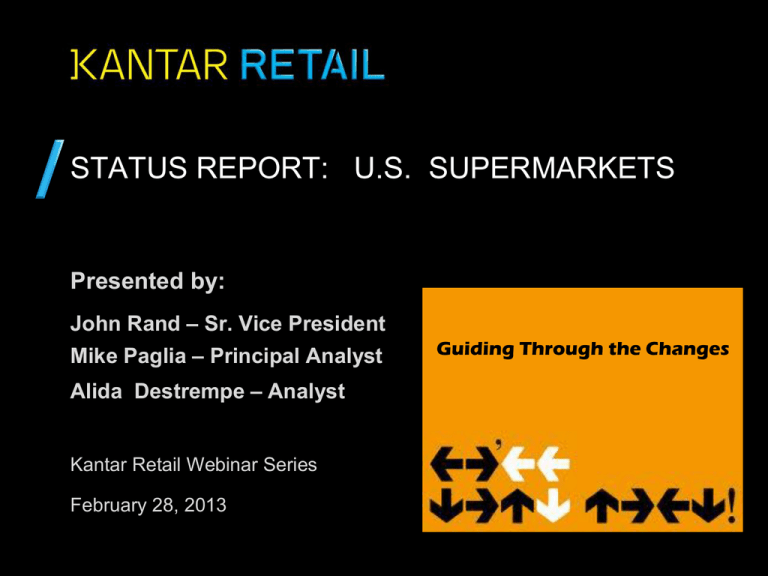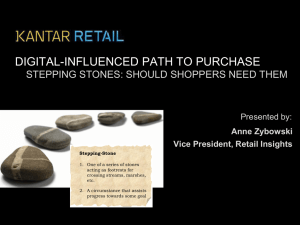
STATUS REPORT: U.S. SUPERMARKETS
Presented by:
John Rand – Sr. Vice President
Mike Paglia – Principal Analyst
Alida Destrempe – Analyst
Kantar Retail Webinar Series
February 28, 2013
Guiding Through the Changes
Copyright © 2013 Kantar Retail. All Rights Reserved.
245 First Street, Suite 1000, Cambridge, MA 02142 (617) 588-4100
howard.zimmerman@kantarretail.com
No part of this material may be reproduced or transmitted in any form or by any means,
electronic or mechanical, including photography, recording, or any information storage and
retrieval system now known or to be invented, without the express written permission of
Kantar Retail.
The printing of any copies for back up is also strictly prohibited.
Disclaimers
The analyses and conclusions presented in this seminar represent the opinions of Kantar
Retail. The views expressed do not necessarily reflect the views of the management of the
retailer(s) under discussion.
This seminar is not endorsed or otherwise supported by the management of any of the
companies covered during the course of the workshop or within the following slides.
© Copyright 2013 Kantar Retail
The Lost and the Limping
Source: Kantar Retail analysis
© Copyright 2013 Kantar Retail
3
Fresh & Easy – Never Quite Took Off
Early Hopes Were High
1,000
Store Count
205
Projected (2006)
Today
$1,200
$1,000
Net Loss (USD millions)
25%
Sales
$1,133
20%
$985
Sales per Sq Ft % Chg
$800
15%
$766
$600
$556
10%
-$208
-$253
-$245
-$307
$400
$359
5%
$200
$32
$-
0%
2007
2008
2009
2010
2011
Source: Kantar Retail analysis; company reports
2012E
© Copyright 2013 Kantar Retail
4
So What Went Wrong?
Multiple Factors in Play
1. Confusion and a
failure to deliver
2. Bad timing (Great
Recession)
3. Tough market
Source: Kantar Retail analysis
"We’ve done the research and we’ve
done something uniquely different for
the American market…we have a new
proposition and that’s what gives us a
much better chance.“
-Tim Mason, 12/19/2007
•
•
•
•
Promotional items OOS
Little in store labor
Self checkout unappealing
Low selection quality in
fresh
© Copyright 2013 Kantar Retail
5
Now What Happens Next?
The Void Will be Quickly Filled
Source: Kantar Retail analysis
Fresh & Easy
~7,000-10,000
sq ft
Aldi
-2,500 sq ft
Family Dollar
~7,500 sq ft
Dollar General
~7,500 sq ft
DG+
~10,000 sq ft
DG Market,
Neighborhood
Market
Save Mart,
99 cents Only
16,000+ sq ft
© Copyright 2013 Kantar Retail
6
Supervalu Calls “Do Over”
Undoing the Past Seven Years
1
2
3
4
5
6
7
8
9
10
11
12
13
14
15
16
17
18
19
20
21
22
Kroger
Supervalu
Safeway
Publix
Ahold
Delhaize
H-E-B
Wakefern
Whole Foods
Bi-Lo
Hy Vee
Wegmans
Giant Eagle
A&P
DeCA
Save Mart
Winco
Walmart (N Mkt)
Harris Teeter
Roundys
Stater Bros
Albertsons (LLC)
2012E Sales 2012E Square Footage
(USD millions)
(millions sq ft)
$91,528
147.6
$35,415
76.4
$35,226
70.7
$27,776
49.8
$25,408
39.8
$17,863
56.2
$17,767
20.0
$12,370
12.9
$11,174
12.5
$8,947
29.6
$7,031
13.1
$6,736
8.3
$6,547
14.1
$6,022
11.7
$5,143
5.4
$5,139
11.1
$5,026
8.4
$4,877
10.6
$4,535
10.1
$3,926
11.4
$3,809
5.8
$3,671
9.9
Source: Kantar Retail analysis
1
2
3
4
5
6
7
8
9
10
Kroger
Safeway
Publix
Ahold
New Albertsons
Supervalu
Delhaize
H-E-B
Wakefern
Whole Foods
2012E Sales 2012E Square Footage
(USD millions)
(millions sq ft)
$91,528
147.6
$35,226
70.7
$27,776
49.8
$25,408
39.8
$20,498
53.3
$18,591
33.1
$17,863
56.2
$17,767
20.0
$12,370
12.9
$11,174
12.5
© Copyright 2013 Kantar Retail
7
Supervalu’s Future
Intertwined with Albertsons
1.
2.
3.
Source: Kantar Retail analysis
Management
Debt
30% ownership
stake
© Copyright 2013 Kantar Retail
8
More Questions Than Answers
Total Debt
$8,000
Project THOR ??
$7,000
$6,000
$5,000
$3.3B
$4,000
Value Transformation ??
$3,000
$2,000
Hyperlocal ??
$1,000
$0
2010
2011
2012
“Fair price plus promotion”
Executive changes
Poor price perception
Low morale
Source: Kantar Retail analysis
model ??
1. Wait and see
2. Evaluate current investment
3. Engage in scenario planning
© Copyright 2013 Kantar Retail
9
Turbulence at Delhaize
Organizational shake up
105
• New CEO: Roland Smith
72
• 500 corporate level lay offs
• Reshuffling of roles
Strategic Task Force
• Establish operating
principles
• Determine right
structure
• Clarify vision
Source: Kantar Retail analysis
Consolidate and simplify priorities:
• Hundreds → a dozen
© Copyright 2013 Kantar Retail
10
The Bad Hides the Good
Delhaize America Sales (USD Billions)
$8.0
$7.5
$7.0
$6.5
$6.0
$5.5
$5.0
$4.5
$4.0
Q2
Q3
Q4
Q1
2010
Q2
Q3
Q4
Q1
2011
Q2
Q3
2012
Bottom Dollar Sales per Store (USD 000's)
$10,000
$9,000
$8,000
$7,000
$6,000
$5,000
$4,000
$3,000
$2,000
$1,000
$2007
Source: Kantar Retail analysis
2008
2009
2010
2011
2012E
© Copyright 2013 Kantar Retail
11
Changing of the Guard
Steve Burd
Robert Edwards
• Current President
• CFO & EVP
• Back filled by Peter Bocian
• Director – KKR
• Director – Casa Ley
Source: Kantar Retail analysis
© Copyright 2013 Kantar Retail
12
Ch-Ch-Ch-Ch-Changes
Making Sense of it All
– The common theme here: Transition
– Increasing demand to be comfortable with volatility
– Creates need for a new set of skills:
• Flexibility
• Receptivity
• Ability to recast customers in a new light
Source: Kantar Retail analysis
© Copyright 2013 Kantar Retail
13
Organic and Natural Transitions – How it
Impacts the Customer
© Copyright 2013 Kantar Retail
14
Organic/Natural Has Been Building for Awhile
A Brief History Lesson
1920-1940
1940-1950
Writers in the U.S. and Great Britain
published influential works introducing the
basic idea of organics - that the health of
plants, soil, livestock and people are
interrelated - and advocating a fundamental
approach to farming based on
understanding and working with natural
systems rather than trying to control them.
1980
Safer Way Natural
Foods and Clarksville
Natural Grocery join
forces to open Whole
Foods Market in Austin,
Texas with a staff of
only 19.
A loose network of
farmers shunned
chemical agriculture
by farming organically
and writing about their
experiences.
1990
The organic industry had
estimated sales of more than $1
billion and Congress passed the
Organic Foods Production Act of
1990, which established the
framework to create National
Organic Standards.
1953
Natural Food Associates
(NFA) was formed in
Atlanta, Texas, to help
connect scattered
organic growers with
fledgling markets for
organically grown foods.
1962
1970s
Rachel Carlson's Silent Spring
was published, documenting
some of the negative
consequences associated with
chemical use in agriculture,
which jump started
environmental consciousness
and a renewed focus on organic
agriculture.
2000
The USDA's Economic Research Service
released a major study on the status of
organics in the U.S. showing that
certified organic crop land more than
doubled during the previous decade and
that some organic livestock sectors—
eggs and dairy—grew even faster.
Growth of the organics industry prompted
activists across the U.S. to form regional
groups and create organic standards by
which to certify farmers and their crops. A
group of farmers formed California Certified
Organic Farmers, becoming the first
organization to certify organic farms in
North America.
2001
2002
USDA passes the Final
Organic Rule after
reinstating prohibitions on
irradiation, sewage sludge
and genetically engineered
seed.
Deadline for
compliance with
the provisions
of the Final
Organic Rule
“78% of US families are choosing organic foods.”
- Organic Trade Association
Today
Growth of Natural & Organic Product sales are being fueled by:
• Shoppers becoming more educated about health & environment
• Taste better than conventional counterparts
• Consistent, favorable media attention on Nat/Org products
• Growing ‘foodie’ movement
• Rising popularity of yoga
- Natural Foods Merchandiser & Nutrition Business Journal
Source: Kantar Retail analysis; WholeFoods.com
© Copyright 2013 Kantar Retail
15
What’s The Difference?
Natural vs. Organic
A major factor that
consistently influences
shopper’s buying
organic/natural products is
education.
In store guidance
through marketing
signage or
employees.
Source: Kantar Retail analysis; Stonyfield.com and store visits
© Copyright 2013 Kantar Retail
16
Natural & Organic Food Sales Growth
$61.2 Billion Industry by 2015E
$70
$61.2
$60
$56.5
Organic Food Sales
$48.2
Natural Food Sales
$50
USD Billions
$52.2
$41.4 $44.6
$40
$36.3
$31.9
$32.7
$30
$20
$10
$24.4
$18.4 $21.2
$16.4
$13.0 $14.7
$11.4
$28.3
$18.3
$13.3
$34.8
$38.3
$23.4
$25.1
$27.0
$29.3
$20.5
$21.6
$21.2
$22.9
$26.4
$19.5
$24.6
$18.0
2010
2011E
2012E
2013E
2014E
2015E
$15.6
$9.9
$5.8
$7.0
$8.2
$8.2
$9.8
$12.7
$15.8
$7.7
$8.5
$14.4
$7.2
$11.1
$16.7
2000
2001
2002
2003
2004
2005
2006
2007
2008
2009
$0
….as well as Nat/Organic retailers’ footprints
+ a number of independent
retailers
Kantar Retail analysis; Nutrition Business Journal, Organic Trade Association, US Dept. of Agriculture
© Copyright 2013 Kantar Retail
17
In The News:
Announcements of Major Expansion Plans
2012
2012
Announced
expansion
plans in:
-Florida
-Indiana
-Pennsylvania
-Illinois
Better position to compete
against larger players.
Source: Kantar Retail analysis; retailer websites
2013
Announced
further
expansion
plans in:
-Northeast
-California,
-Northern
Virginia
2012-2013
•Plans to expand to 1,000
stores
• It has been reported that it
will like to open new stores
in smaller markets and
underserved urban
locations.
© Copyright 2013 Kantar Retail
18
Conclusion: Organic, Niche Retailers are Growing
Shaking Up the Grocery Industry
Trader Joes
376
395
408
423
452
438
467
Sprouts
146
161
175
190
221
206
103
2011
2012E
2013E
2014E
2015E
2016E
164
2011
2012E
2013E
2014E
2015E
2016E
Whole Foods
Fresh Market
148
2017E
195
180
210
309
333
365
389
411
431
2017E
453
131
113
2011
2012E
2013E
2014E
2015E
2016E
Source: Kantar Retail analysis; company reports
2017E
2011
2012E
2013E
2014E
2015E
2016E
2017E
© Copyright 2013 Kantar Retail
19
Next To the Big Guys
Natural & Organic Outpace Rest of Channel
2007
Sprouts
Fresh market
Whole Foods Market
Safeway
Kroger
Publix
US Supermarket Channel
$
$
$
$
$
$
276.90
728.41
7,154.93
36,141.94
59,408.27
22,869.52
340,116,500,256
2012
$
$
$
$
$
$
1,994.89
1,290.61
11,173.94
35,225.53
82,270.90
27,776.22
380,664,743,492
2017
$
$
$
$
$
$
07 - '12 CAGR
3,587.60
2,499.19
19,689.82
35,953.84
115,937.09
34,431.75
475,577,395,830
48.4%
12.1%
9.3%
-0.5%
6.7%
4.0%
2.3%
12 - '17E
CAGR
12.5%
14.1%
12.0%
0.4%
7.1%
4.4%
4.6%
Note: supermarket format sales only
Source: Kantar Retail analysis; company reports; store visits
© Copyright 2013 Kantar Retail
20
What is The Fresh Market?
Quick Store Tour
Heightening the
Experience
• Dim lighting
• Cleanly merchandises
• Unique mix of products
• Service-oriented
Source: Kantar Retail analysis; store visits
• Private label takes
center stage
•National, well-known
brands have low
precedence
• Unique Brands are
more apparent
© Copyright 2013 Kantar Retail
21
What is Sprouts? Understanding This Retailer
Quick Store Tour
Store design appear
to be a hybrid of
Trader Joe’s and
Whole Foods
• Sprouts pushes
produce to win
over shoppers.
• Competes with
national retailers
through its low
price produce
items.
Source: Kantar Retail analysis; Facebook.com
© Copyright 2013 Kantar Retail
22
How Conventional Retailers Play in this Space
Store-Within-A-Store is a Common Solution
…plus products are integrated within
the rest of the store.
Nat/Organic products are
part of the brand’s overall
H&W strategy
Curved shelves and
signage to call out
organic/natural
products.
Source: Kantar Retail analysis; store visits
© Copyright 2013 Kantar Retail
23
Natural & Organic Expensive?
Retailers Offer a Strong Value Proposition
Price
message
Value
Adds
Source: Kantar Retail analysis; store visits
© Copyright 2013 Kantar Retail
24
Natural & Organic: Retailer’s Brand Portfolio
Adding to the Value Proposition
2002
2002
2004
Wegmans Harris Teeter
Ahold
Organic
Naturals
Nature’s
Promise
2005
Safeway
O Organics
2007
2007
Meijer
Delhaize
Organics Nature’s
Place
2008
Supervalu
Wild
Harvest
2010
Safeway
Open
Nature
2012
Kroger
Simple
Nutrition
2013
Aldi
Simply
Nature
• Private Label allows retailers to boost profitability
• Nat/Organic store brands allow conventional retailers to compete more strongly against niche stores.
• Give shoppers opportunity to purchase premium quality items at a low price.
Source: Kantar Retail analysis
© Copyright 2013 Kantar Retail
25
Taking Up Already Limited Shelf Space
Not Only Defend from Private Brand, But Natural/Organic
Double placement:
organic vs. conventional
Center Store
Source: Kantar Retail analysis; store visits
End Caps
SWAS
© Copyright 2013 Kantar Retail
26
It Will Keep on Expanding: Even Aldi Has Organics
Harm its Price Perception Among Shoppers?
Giving low-income
shoppers the opportunity
to access a premium
quality item at a low price
point.
Price points are only 50
cents more than the nonorganic.
Source: Kantar Retail analysis; store visits & Aldi.com
© Copyright 2013 Kantar Retail
27
Summary: Supplier Implications
Clearly not all items can be organic certified. With that said, suppliers can think
about the following when competing against this new consumer trend:
– Recently many organic products have become more competitively priced relative to
the comparable non-organic item through the creation of nat/org private label.
• Suppliers will need to start showcasing their ‘conventional’ product value
beyond price. In marketing terms, utilizing characteristics such as fresh, value,
taste – attributes that define quality – to help drive consumer purchase
behaviors.
– Develop a Private Label AND Natural Organic Defense Strategy
• Assess how you can position your brands to work with retailer brands versus
compete. How can you link your items to a retailer’s natural/organic items?
Meal solution displays, health and wellness marketing campaign, etc?
Source: Kantar Retail analysis
© Copyright 2013 Kantar Retail
28
Who’s Winning and Why
(and what you should be doing about it)
© Copyright 2013 Kantar Retail
29
The Evolution of Grocery
The “Food Continuum”: the Origin of Fragmentation
– ~5000 items, 10-15K sq. ft.
– The store evolves the fresh perimeter, 25K sq.ft
– Evolution to include Rx, etc. in 40K sq.ft. –differentiation was
regionally based
– Club stores and hypermarket increased the size, added G.M.
as a core offer – with very different assortments and very
different business models
Online
Value
Discounter
Clubs
• National presence caused further fragmentation and
differentiation
– Value discounters re-established the small market – with
both food and G.M.
– KEY: Nothing disappeared!
– And then we add Online
Hypermarket
Food/Drug
Supermarket
Conventional Market
Source: Kantar Retail analysis
© Copyright 2013 Kantar Retail
30
Non-Edible Grocery Sales % by Channel
100%
90%
0%
4%
1%
80%
8%
70%
$766
0%
4%
1%
8%
6%
16%
USD Billions
6%
60%
5%
16%
50%
18%
$917
1%
6%
1%
1%
6%
1%
9%
9%
5%
16%
$1098
0%
7%
1%
0%9%
7%
1%5%
9%
19%
5%
5%
4%
3%
16%
20%
19%
19%
Department
Non Store Retail
Cash and Carry
Discounter
Convenience
DrugDepartment
Mass Merch Excluding Supercenter
Cash and Carry
Hypermarket
Convenience
Supermarket
Mass Merch Excluding Supercenter
Hypermarket
40%
4%
3%
30%
20%
Discounter
Drug
5%
18%
Non Store Retail
41%
20%
37%
Supermarket
38%
19%
10%
0%
2007
Note: %s are Kantar Retail estimates
2012E
41%
Source: Kantar Retail analysis; company reports
2017E
© Copyright 2013 Kantar Retail
31
Edible Sales % by Channel
Steady Outlook for Supermarkets
100%
0%
1%
4%
9%
90%
80%
70%
6%
2%
2%
19%
$480
0%
4%
1%
9%
6%
2%
2%
19%
60%
0% $573
5%
1%
0%
6%0%
1%
1%
10%
5%
10%
10%
5%
3%
2%
0%
$695
1%6%
10%
5%
3%
2%
6%
6%
3%3%
1%1%
21% 21%
20%
20%
Non Store Retail
Non
Store Retail
Discounter
Discounter
Department
Department
Cash and Carry
Cash and Carry
Convenience
Convenience
Drug
Drug
MassMerch
Merch
Excluding
Supercenter
Mass
Excluding
Supercenter
Hypermarket
Hypermarket
Supermarket
Supermarket
50%
40%
30%
20%
57%
57%
52%
52%
52%
52%
10%
0%
2007
Note: %s are Kantar Retail estimates
2012E
2007
2012E
Source: Kantar Retail analysis; company reports
2017E
2017E
© Copyright 2013 Kantar Retail
32
US Sales by Format
$2,386
$193
2,000
$1,898
$1,679
Sales in Billions ($)
1,600
$102
$105
$368
1,200
800
$48
$107
$47
$141
$110
$138
$376
$124
$78
$63
$102
$102
$51
$95
$70
$168
$205
$271
$107
$108
$129
$229
$218
400
$447
$341
$382
2007
2012E
$317
$478
CAGR
'07-'12E
CAGR
'12E-'17E
Apparel
Apparel
1.5%
5.2%
Clubs
Clubs
5.6%
7.0%
Category
Specialist
Category
Specialist
0.4%
3.5%
Convenience
Convenience
1.4%
4.2%
Department
Department
-2.3%
1.5%
Discounter
Discounter
8.2%
7.9%
Drug
Drug
3.6%
4.1%
Supercenter
Supercenter
4.4%
3.2%
Mass
Mass
-2.6%
-0.3%
Store
Retail
NonNon
Store
Retail
10.6%
12.3%
Supermarket
Supermarket
2.3%
4.6%
2.5%
4.7%
Channel
KR Channel Totals
-
2017E
NOTE: All data as of 11/21/12
Source: KantarRetailIQ.com
© Copyright 2013 Kantar Retail
33
Growth Not Scale, Mix, Value, History, or Footprint
Top 20 Supermarket Retailers Account for 92.5% of Sales Added from 2012E-2017E
Rank % Sales Added (US Supermarket Sales)
Retailer
1
2
3
4
5
6
7
8
9
10
11
12
13
14
15
16
17
18
19
20
Kroger
Walmart *
Whole Foods
Publix
H-E-B
Top 5 Total
Ahold
Wakefern
Wegmans
Winco
Meijer **
Sprouts
Harris Teeter
Hy Vee
Giant Eagle
Fresh Market
Top 15 Total
Grocery Outlet
Chedraui
Delhaize
Roundys
Bi-Lo
Top 20 Total
**Total Grocery only. NOTE: All data as of 11/21/12
Source: Kantar Retail analysis; company reports
Sales 2012E
(USD millions)
$82,271
4,877
11,174
27,776
17,767
$143,865
25,408
12,370
6,736
5,026
9,855
1,995
4,535
7,031
6,547
1,291
$224,658
1,273
1,128
17,863
3,926
8,947
$257,794
Sales 2017E
(USD millions)
$115,937
15,319
19,690
34,432
23,356
$208,733
29,782
15,883
9,606
7,204
11,494
3,588
5,984
8,382
7,866
2,499
$311,020
2,242
2,072
18,774
4,816
9,777
$348,702
Sales Added
2012E-2017E
$33,666
10,442
8,516
6,656
5,589
$64,868
4,374
3,512
2,870
2,178
1,640
1,593
1,449
1,350
1,320
1,209
$86,362
970
944
911
890
830
$90,907
% of Total Sales
Added 2012E-2017E
34.3%
10.6%
8.7%
6.8%
5.7%
66.0%
4.5%
3.6%
2.9%
2.2%
1.7%
1.6%
1.5%
1.4%
1.3%
1.2%
87.9%
1.0%
1.0%
0.9%
0.9%
0.8%
92.5%
*includes supermarket sales only (supermarket format only).
© Copyright 2013 Kantar Retail
34
Regional Performance Outlook
The Under Resourced Over Achievers
Greater than channel
average
Retailer
Store '12E - '17E CAGR
Sales '12E - '17E CAGR
Ahold
Bi-Lo
Delhaize
Fresh Market
Giant Eagle
Harris Teeter
H-E-B
Hy Vee
Ingles
Meijer
Publix
Roundys
Save Mart
Tesco
Wakefern
Wegmans
Winco
Supermarket
0.8%
0.0%
1.6%
9.9%
2.6%
2.7%
2.3%
1.0%
0.3%
0.4%
3.0%
2.3%
1.2%
6.4%
2.3%
2.8%
4.8%
1.7%
3.3%
1.8%
2.1%
14.1%
4.1%
5.7%
5.7%
3.5%
3.3%
3.1%
4.5%
4.2%
2.9%
10.9%
5.5%
7.4%
7.5%
4.6%
*includes total company US sales (all formats; convenience, online, supermarket, etc)
Source: Kantar Retail analysis; company reports
Source: Kantar Retail analysis; company reports
© Copyright 2013 Kantar Retail
3535
Multiple Layers of Polarization
– More than 10% of total supermarket sales growth will come from
pure natural / organic formats
– 60% of the growth in the channel will come from value oriented
operators – while almost 30% will come from retailers who
position themselves as premium
– 7 of the top 15 supermarket retailers run multiple formats
‘17E % to
Channel
‘12E-’17E
CAGR
Natural/Organic
5.0%
11.0%
Value
47.2%
5.5%
Premium
(ex. Nat/org)
23.1%
2.9%
Mainstream
23.9%
1.8%
Total Channel
N/A
4.1%
Source: Kantar Retail analysis
© Copyright 2013 Kantar Retail
36
A Vast Competitive Portfolio
Retailers Must Literally be More Attractive – while
Shoppers Cross-Shop Relentlessly
“Capture Rates” for Food and Groceries, 2012
(% of retailer’s past four-week shoppers who spend most on food/groceries at that retailer)
Rank
Retailer
Capture
Rate
Rank
Capture
Rate
Retailer
1
ShopRite
58%*
11
Walmart/WMSC
34%
2
H-E-B
52%
12
Harris Teeter
34%
3
Kroger (all banners)
43%
13
Wegman’s
31%
4
Publix
42%
14
Ahold (all banners)
30%
5
Meijer
41%
15
Safeway (all banners)
30%
6
Giant Eagle
41%
16
Delhaize (all banners)
25%
7
Stater Brothers
41%
17
Supervalu (all banners)
22%
8
Winco Foods
36%
18
Winn-Dixie
21%
9
Pathmark
35%
19
A&P
20%
Hy-Vee
35%
20
ALDI
18%
10
Regional Grocers
National Grocers
*Read as: Among all the past four-week ShopRite shoppers surveyed, 58% said they had spent the most on food/groceries at ShopRite
Source: Kantar Retail ShopperScape®, Feb//May/Aug/Nov 2012
© Copyright 2013 Kantar Retail
37
Implications: Retailer Competitive Trends
– Urban and convenience trends are mutually reinforcing and drive a steady decrease in
store size – everyone from Value to Supermarket to Mass operators is working on
rolling smaller buildings
• Obvious implications for space and SKU distribution – physical package efficiency, moderate
pack sizes, restricted assortments – all challenge new item development
– Online is by contrast capable of supporting virtually unlimited variety – but is a poor
environment for impulse or immediate fulfillment
Actions:
– Merchandising and marketing MUST improve and integrate online, instore, trade and consumer
– Retailers are highly differentiated and increasingly variable.
Standardized products will increasingly be rejected unless the programs
and merchandising can make them appear “functionally” customized.
– Shopper information increases exponentially. Budgetary planning and
shopper analysis skill development are critical components
Source: Kantar Retail analysis
© Copyright 2013 Kantar Retail
38
Observable Trends
– More variable sized stores – urban and convenience trends
are mutually reinforcing
– Improved Merchandising – more design, new “look and feel”,
more shopper guidance, less supplier influence
– More curated assortments – more targeting
– More data to enable everything
– Multi Channel – definitely for marketing, increasingly for
fulfillment
– More services – health and wellness, delivery, lifestyle
engagement, diet, self scanning, gifting, cooking,
conversation, localization, etc, etc, etc.
© Copyright 2013 Kantar Retail
39
Changing Nature of Value
Shoppers have two prevailing approaches to
maximizing value
Quest for ever-better
value: lowest price or
“a good deal”
Proactive creation of
value using tools and
technology
Source: Kantar Retail analysis
© Copyright 2013 Kantar Retail
40
Multi-Channel Grocers are Winning Shoppers
And Consolidating Spend in a Tough Environment
“Capture Rates” for Food and Groceries
(% of retailer’s past four-week shoppers who spend most on food/groceries at that retailer)
Rank
Retailer
Capture
Rate
1
H-E-B
55%*
2
ShopRite
55%
3
Publix
44%
Across All MWG Stores: Y-O-Y
4
Kroger (all banners)
44%
• Dollar Growth +12.4%
5
Giant Eagle
42%
6
Meijer
41%
• Unit Growth +10.1%
7
WinCo Foods
41%
• Basket Growth +13.0%
8
Wegmans
37%
• Customer Count Growth +8.4%
9
Hy-Vee
36%
• Same Store Dollar Growth +9%
10
Harris Teeter
36%
Regional Grocers
National Grocers
Click&Collect or MyWebGrocer
*Read as: Among all the past four-week H-E-B shoppers surveyed, 55% said they had spent the most on food/groceries at H-E-B.
Source: Kantar Retail ShopperScape®, May/Aug/Nov 2011 and Feb/May 2012 - MyWebGrocer
© Copyright 2013 Kantar Retail
41
Implications: the Online Influenced Shopper
– This set of expectations is radiating upward to older generations as
well, particularly Gen X, as smartphone usage and capabilities
increase
– Center store effectiveness, especially in Mass and Grocery will
become critical as shelf stable categories migrate to online order and
pickup models such as Site to Store, leading to pervasive SKU
reductions and declining inventory requirements on shelf
– Action: Suppliers can create leadership in test-learn-apply
projects that retailers will almost certainly undertake to improve
merchandising
– Action: measure the return per square inch at retail for your
items as part of any category analysis. Item introductions which
do not raise the velocity / return of the space will become much
more expensive to maintain on shelf
© Copyright 2013 Kantar Retail
42
Customization is the way of the future
Source: Kantar Retail Category Leadership Study, 2011
Source: Kantar Retail analysis
© Copyright 2013 Kantar Retail
43
So How Do You Build A Strategy?
Multi Step Process
1. Assess the retailer’s Economics
How do they make money?
Growth is more important than scale over time; margin matters; consider
operational metrics such as turns, sales/sq ft
2. Assess their Shopper Facing Skill Sets
Now: Can they deliver on Convenience?
Wow: Can they deliver on Experience?
Right: Do they tailor stores to meet shopper preferences and create
brand trust?
Smart: Do they know their shoppers? Do shoppers feel smart when
they shop there?
3. Evaluate their Operations
Are they consistent and reliable partners? Innovative?
© Copyright 2013 Kantar Retail
44
Applying the Capabilities
The Basis for Assessing the Customer
WOW NOW RIGHT SMART
Source: Kantar Retail analysis
© Copyright 2013 Kantar Retail
45
Retailers Don’t Develop Evenly
Even if Nominally the Same Channel
CAGR
(‘12E-’17E)
5.5%
CAGR
(‘12E-’17E)
11.7%
KROGER
WHOLE FOODS
WOW
50
WOW
100
NOW
75
NOW
25
RIGHT
100
RIGHT
75
SMART
100
SMART
50
Source: Kantar Retail analysis
© Copyright 2013 Kantar Retail
46
Summary Eye Chart:
Four clusters of capabilities
Best customers will learn to do more
than one of these well
Deliver on
Experience
Ability to
Execute
On Trend
Differentiated
& Focused
Stores
MultiChannel
Right
SMART
NOW
WOW
Manage
Shoppers
Time
Clear Value
Perpception
Master of
Promotion
Financially
Competent
Know &
Engage
Shoppers
Collaborative
Master of
Brand
Ahold
Bi-Lo
Delhaize
Fresh Market
Giant Eagle
Harris Teeter
HEB
Hy-Vee
Meijer
Price Chopper
Publix
Save Mart
Sprouts
Trader Joes
Wakefern
Wegmans
Winco
Source: Kantar Retail analysis
© Copyright 2013 Kantar Retail
47
Summary of Implications for Planning
– The shopper base in the U.S. is highly variable and multiply polarized.
Very few products and almost no marketing or communications will
translate equally well across the entire landscape
• Fewer “home runs” and more “singles”
– Shoppers expectations of the retail environment are irrevocably changed
by the online and mobile digital experience
• Finding ways to deliver an enhanced in-store
shopping experience that aligns to this is the best
way to ensure survival in the brick and mortar retail
world
Source: Kantar Retail analysis
© Copyright 2013 Kantar Retail
48
Summary of Implications for Planning
– The highly variable and increasingly targeted world of retailers will demand
more variable responses than most traditional CPG companies currently
deliver or are comfortable trying to do
• Finding a path to aggregate and respond to variable opportunities
will demand a more flexible offer and more flexible structure to
manage it profitably
– We call this Dynamic Clustering
– Digital and Mobile. Now. Or you will lose an entire generation before the
end of the decade.
• A wide range of social, mobile, digital and online efforts are in
play, and experiment, testing and adapting to them will be time
consuming but is not likely to be optional
Source: Kantar Retail analysis
© Copyright 2013 Kantar Retail
49
Learn more about the industry
leader
Kroger Supersession
March 19–20, 2013 | Cincinnati, OH
Understand why club, dollar stores, and Walmart continue
to become significant competitors
Kroger’s expansion into small store formats and its
Marketplace banner how should you advise and react
Using data from ShopperScape® to explore how trip
missions have changed and how you can react
How would the collapse of a major player effect Kroger?
Receive a solid overview of the supermarket industry and
the probable directions in the next 3-5 years
Four Mega-trends: Supermarket 2020
The New Merchandising / The New Marketing / The New
Store / The New Fresh
The Kroger Shoppers In Context
•
•
•
What are the underlying changes in the macro landscape
How are the shopping behaviors and attitudes of Kroger
shoppers shifting? Does it differ by key demographic
segments?
And what does that mean for Kroger’s key strategic initiatives?
© Copyright 2013 Kantar Retail
SHAREGROUPS
ShareGroups bring together non-competitive
companies to have open, in-depth
conversations about common challenges and
opportunities.
• We share real-life examples of best
practices from team members that provide
relevant, actionable insights and the
opportunity to question and understand what
works and why.
• We brainstorm and problem solve on your
key issues to help create strategies and
solutions.
• We promote new thinking to improve
execution of your business plans.
Next Meeting:
May 16, 2013 in Cincinnati, OH
• Our Grocery Research Group has a
number of categories open in center
store, HBC and perimeter categories
• If you are interested in participating
in this ShareGroup, please contact
your Kantar Retail customer
development team or email:
o Steve.meehan@kantarretail.com
o John.rand@kantarretail.com
© Copyright 2013 Kantar Retail
John Rand
Senior Vice President
Mike Paglia
Principal Analyst
Mike.Paglia@KantarRetail.com
John.Rand@KantarRetail.com
501 Boylston Street
Suite 6101
Boston, MA
02116
P +1 617 912 2860
F +1 630 245 5647
www.KantarRetailiq.com
501 Boylston Street
Suite 6101
Boston, MA
02116
P +1 617 912 2855
F +1 630 245 5647
www.KantarRetailiq.com
Alida Destrempe
Analyst
Alida.Destrempe@KantarRetail.com
Two Easton Oval
Suite 500
Columbus, OH
43219
P +1 614 355 4030
F +1 614 355 4059
www.KantarRetailiq.com
© Copyright 2013 Kantar Retail








